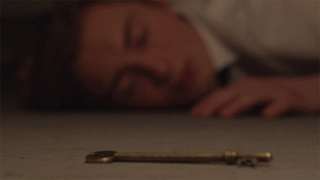The Imitation Game directed by Morton Tyldum, tells the story of a newly created British Intelligence Agency (MI6), which recruits the
mathematics professor Alan Turing and a team of people to break the Nazi Code
Enigma.
Enigma – a person or thing that is
mysterious or difficult to understand. In this case, Enigma is a Nazi German
communicating system that allows the Nazi’s to send messages, such as
co-ordinates to each other.
The film starts with the sound of a Morse code Transmission. This immediately foreshadows the key features of the
film and the viewer has already associated the sound of Morse to a 20th
century telephone system. Therefore, just by beginning with the sound of Morse code,
the viewer has subconsciously estimated the time period of the film, along
with the key feature (The biggest problem is Enigma, a system for communication. Therefore the key feature of this film is telephones.)
The non-diegetic ambient is then played, in which Alexandre Desplat calls ‘Alan’. This music is very mysterious and has a sense of curiosity to it. Through the use of many instruments and different sounds, the music is a very complex piece. Through this music, the viewer gets a sense for the mood of the film; it’s very mysterious and complex along with a sense of curiosity, which are all the traits that the protagonist Turing holds. The viewer gets a hint of Turing’s persona through the ambient music.
The
title card states “1951 Manchester, England” which gives the viewer information
on the time frame and the location of the film. The font used is very old
fashioned and crisp, which shows similarity to a font used in a typewriter.
Again, this foreshadows the key feature and style of the
film.
Before any visual is shown, the
viewer already knows the time frame, location, style of the film as an
informative and historically educative; the mood of the film not as an upbeat
film but dramatically enticing; the characteristics of the protagonist, and the recognition
of the key features such as telephones and Morse communication. This is all
shown through the use of audio and simple information.
The
film starts with the protagonist, Alan Turing, with his eyes closed in what is
clearly a police interview room. The room is clearly a 50’s style shown through
the props and setting, such as the blue bricked walls and dark oak table with
an ashtray on top. The film blacks out and changes it’s setting to what the
viewer believes might be Turing’s room. We know this because the camera pans of the room
are narrated over by Turing, so we associate the two together.
The narrator Turing asks, “Are you
paying attention? Good. If you are not listening carefully, you will miss
things.” Which immediately catches our attention and immerses us into the film.
By asking this simple question we know that the type of this film is one where
the audience must concentrate on what is being shown. This film is of a historically educative and informative genre.
The
camera pans over a clutter of props such as butterfly cases, lattices drawn on
gridded paper, as well as machinery and wiring. This emits a sense of intelligence and complexity, which reflects upon Turing. The camera pan uses proxemic macro angles to
really show details of the props, which visually describes to the viewer of Turing's personality.
“Because I know things that you do not know.” As this narration is said, we see a clip of someone picking up a telephone and then the Manchester Police Department call centre. Because the narration was placed as that clip was shown, together these two clips again foreshadows the key feature of telephones and hints to the viewer of what the film is about.

“If you cannot commit to this then please leave the room.” This simple narration shows Turing’s wit, and therefore reveals to the viewer that there will be a comedic take upon it as well. The character clearly thinks highly of himself and shows no guilt in his actions or choice of words. Turing thinks of himself as a genius and as we are shown visuals of machinery along with the affiliation of the MI6, the audience trusts him as we understand that he is a genius and therefore knows what he is talking about.
The title card reveals more
information of ‘Secret Intelligence Service (MI6) Headquarters’ The WWII military
costumes and setting of the room such as the wooden flooring and furnishings,
as well as the grand concrete staircase; all show a place of high
powered business. We know that Turing will be involved in the MI6 in some way
and therefore we know that the storyline will not be of a casual style.
I
personally love this cinematography of this scene as the 'golden third rule' is
used here. Through the scale of empty space within the room and the
desk towards the back, it shows the wealth and empowerment that the MI6 have.
Overall just through the opening sequence the
director has intrigued you he is associated with the MI6. We want to find
out more about Turing’s characteristics and what he achieves with the key
feature of the film.
Tags:
a1

















1 comments
Very well done, Ella! Your blog looks beautiful and you write beautifully. Your review of The Imitation Game (albeit lacking in 'why you like it') has the start of some really good analysis and it is clear you have engaged with the task. Well done.
ReplyDelete